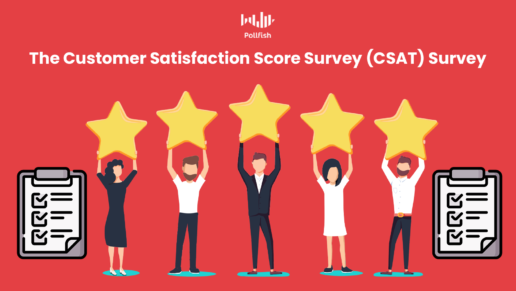Diving into the Customer Service Satisfaction Survey to Improve All Customer Service Sessions
Diving into the Customer Service Satisfaction Survey to Improve All Customer Service Sessions
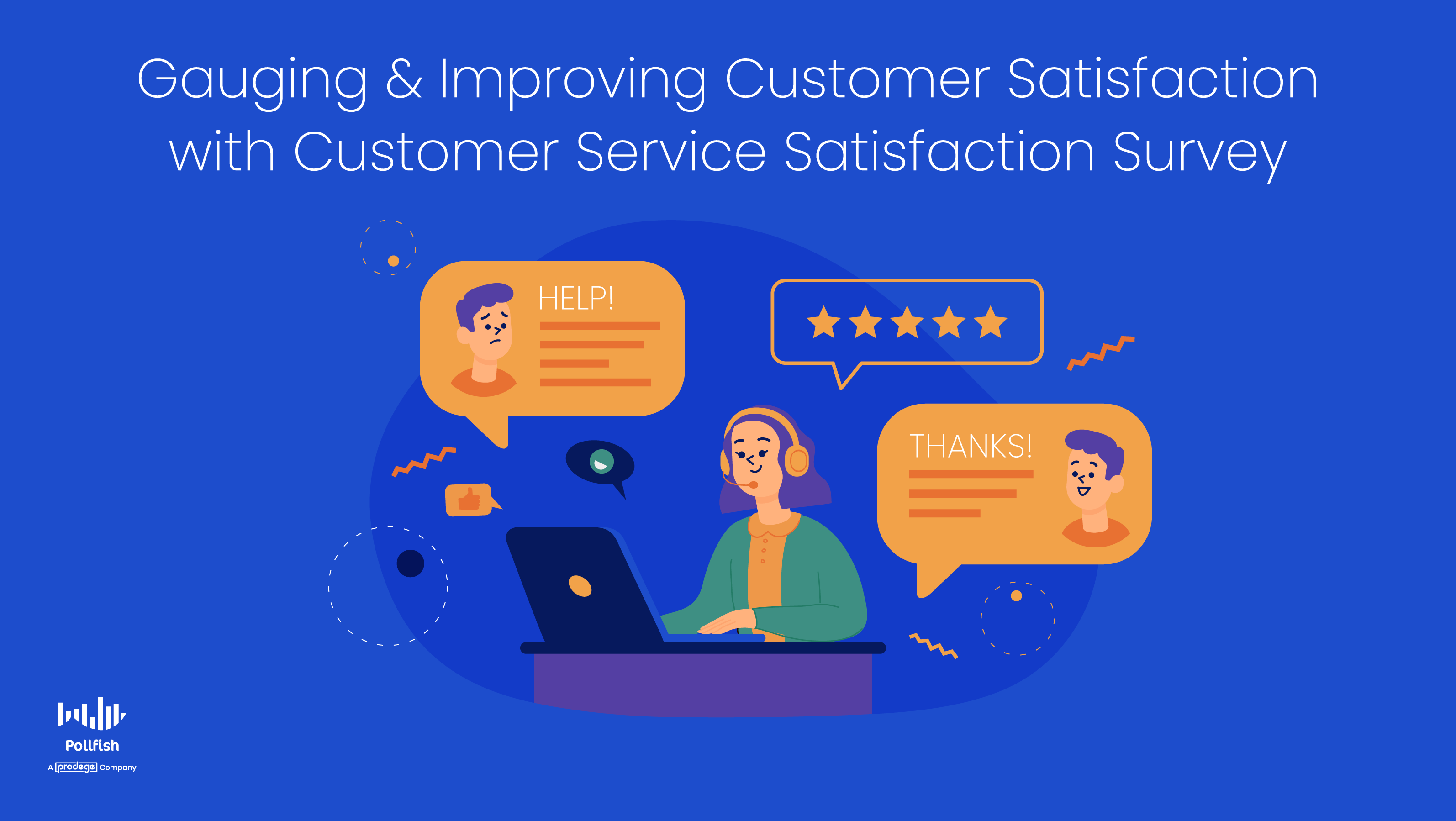
The customer service satisfaction survey is the chief tool to use to assure you offer the best customer service sessions. Your customers are bound to elicit customer service activities with your business, no matter how well they know your products.
Whether it’s for technical support, a glitch in a product or help with your digital properties, seeking out and receiving customer service is a major part of your customer experience. It can occur in all parts of the customer buying journey, including pre-sales and post-sales periods.
As such, you’ll need to optimize your customer service satisfaction, just as you would with any other part of your CX. This is also because customers don’t keep their brand perception to themselves.
72% of customers will share a positive customer service experience with 6 or more people. However, unsatisfied customers also share their experiences; 13% of unhappy customers will share their experiences with 15 people or more.
To take matters into further perspective, 70% of customers say they’ll support a company that delivers great customer service. 17% of Americans are even willing to pay more for a business that has a good reputation regarding its customer service.
These statics prove the weight that customer service satisfaction has on businesses. You can optimize yours by gauging this experience through surveys.
This article explains the customer service satisfaction survey, its importance, when to use it and how to create one.
Understanding the Customer Service Satisfaction Survey
The customer service satisfaction survey is a survey that inquires into customer service satisfaction, as its name suggests. It is a kind of customer service survey, but it should not be mistaken for one, as there are a few distinctions between the two.
The customer service survey is a broader survey type that can be used across the customer buying journey, whereas the customer service satisfaction survey specifically focuses on the satisfaction portion of a customer service session. In this regard, this survey zeros in on support sessions, which are typically conducted after a customer has already made a purchase.
However, this is not a fast and hard rule, as there are other instances in a customer journey where customers receive customer service. Businesses will need to probe them on their satisfaction with these experiences as well.
As such, this kind of survey is centered on gathering customer feedback on the satisfaction aspect of various kinds of customer service. Businesses can use it to measure customer happiness and dissatisfaction during the service session, learn how to improve their service and discover how to streamline future customer service sessions.
When it comes to differentiating from other customer satisfaction surveys, the customer service satisfaction survey entails using customer service representatives to help come up with the questions. This is because you’ll need to use questions specific to the customer service session; otherwise, your customers won’t want to take part in the survey, as it will come across as too generic and not useful to their situation.
The Importance of the Customer Service Satisfaction Survey
The customer service satisfaction survey is critical to use for a number of reasons, including the ones mentioned in the intro.
To piggyback off of the intro, the importance of this survey comes into play, given that you can use it to improve your overall customer experience. Given that customer service sessions involve interacting with a company, usually for an extended period, it plays a major role in CX.
In fact, 1 in 3 customers will leave a business they love after only one bad experience, while 92% would completely abandon a company after two or three negative interactions. There are many things that contribute to a bad customer service experience — some aren’t as obvious as others.
This is where the customer service satisfaction survey is useful, as it helps you find the things that bother your customers, ones which you may have overlooked or never had considered as sources of problems.
A poor customer service experience can be due to the lack of a follow-up. In this case, businesses that have time-poor employees are at a disadvantage, unless they commit to following up with the customers they’ve assisted in a customer service session.
However, even if you follow up with customers you’ve assisted, the customers themselves may lack the time and will to speak with you, if it’s over the phone. Emailing customers is the easy route; however, they may be unwilling to begin an email conversation with customer service agents.
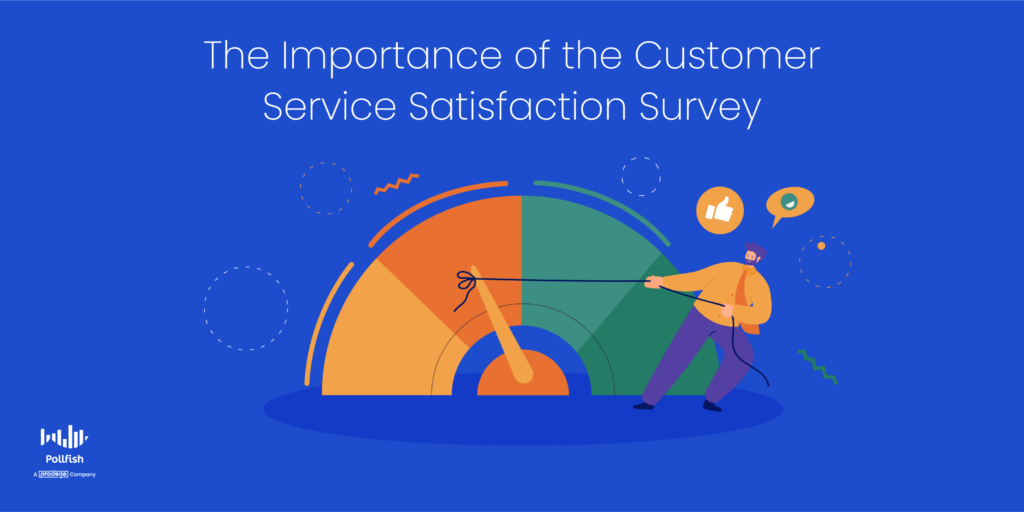
In such a case, the customer service satisfaction survey is especially useful, as it provides a quick and easy method to follow up with your customers after a customer service session. You’ll show your customers you care about their opinions on their customer service experience without asking them for too much time while reaping the benefits of their insights.
As such, this survey helps build connections between you and your customers. The stronger your connection with customers, the more they’ll rely on your products and services. As such, this survey can be used as a tool that goes beyond merely learning about how satisfied customers were with the customer service they got. It also doesn’t stop at improving your CX. Instead, by building relationships with customers, you’re also building brand trust, the cornerstone of consumer loyalty.
Loyal customers are far more inclined on making repeat purchases than causal customers. These are the most quality customers you can strive for, as they will continuously purchase from your brand and even become brand advocates. Loyal customers also tend to have a higher Customer Lifetime Value (CLV).
Given that this survey can help foster brand loyalty and a high CLV, it will in turn lower customer attrition along with your customer churn rate, as you are retaining your customers.
All brands should use the customer service satisfaction survey, as it can reveal critical insights on how to improve your customer service.
When to Use the Customer Service Satisfaction Survey
You’ve probably had various kinds of customer service sessions with your customers. Sometimes, what may appear to be a regular in-store or online encounter, such as a chat, turns out to be something more significant, as it involves customers interacting with your support or sales employees for a considerable amount of time.
Or, it may be quick, but provided invaluable help for your customers. These qualify as customer service sessions as well.
This begs the question of when is the best time to send a customer service satisfaction survey.
The following lists the most apt times to send a customer service satisfaction survey:
- After any situation in which a customer received assistance from an employee, whether it is a customer service employee or others.
- This can involve solicited help, in which customers set up a call or at-home meeting with a representative, or when your employees approach the customers.
- Directly after a scheduled meeting, phone call or other customer service session.
- It is best to let the customers know that you intend to survey them by emailing them.
- This is also a good time to collect their email addresses if you haven’t already.
- This usually occurs after a customer has purchased from you.
- After a customer sampled your product at a store and spoke with a sales representative.
- This occurs usually before a customer has made a purchase and is still deliberating whether to buy from you or a competitor.
- This is a good opportunity to understand customer satisfaction with your customer service in the early stages of your customers’ relationship with you.
- After an impromptu customer service chatting session.
- Some chatting sessions can be minor, with customers asking basic questions that can be found elsewhere on your website.
- But others are more significant, granting key information to customers about all your offerings.
- This can occur at various places in the customer journey, from pre-sales, to after a recent purchase and well after purchasing.
- After customers interacted with a Voice of the Customer (VoC) program, such as a phone call, or in-person experience.
- At times, your support employees may offer specific customer service during these times, so these sessions can extend beyond customers’ venting about their issues or other feedback.
- You can frame the survey as being sent to better help the customers further, even after they gave their VoC feedback.
How to Create a Customer Service Satisfaction Survey
There are various instances where you’ll need to use a customer service satisfaction survey, as the above section explains. They will help you gauge how satisfied your customers are at different points of being served.
If you’re not sure how to go about creating this survey and need a few pointers, the following will guide you.
The following explains how to create a customer service satisfaction survey in a step-by-step way. Check out how to create customer service survey questions.
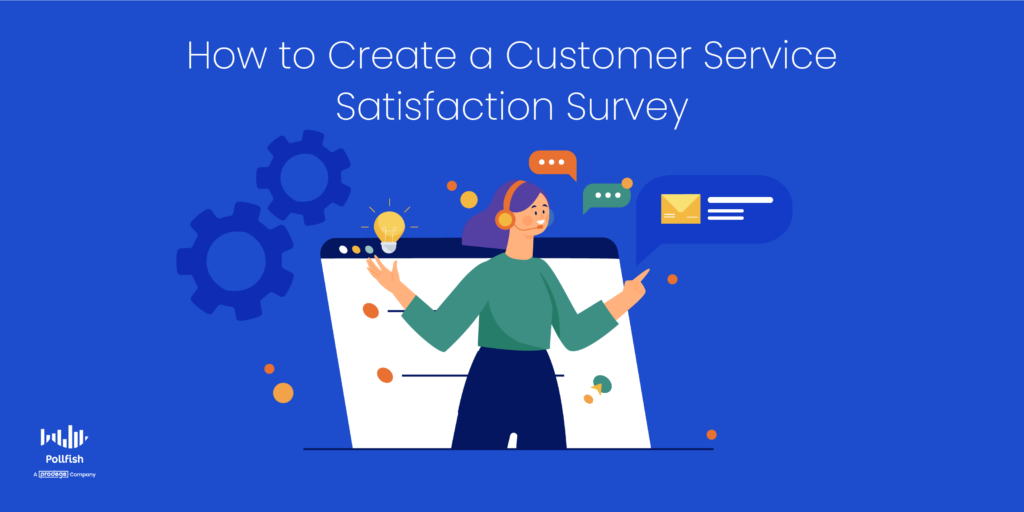
- Determine a recent instance with a customer, in which they received customer service.
- Refer to the above section to help you decide what to accomplish with your customer service satisfaction survey.
- Decide on the correct online survey platform.
- There is a swath of online survey tools but they don’t all offer the same capabilities, user-friendliness and speed to insights as does Pollfish.
- In the screener section of the survey, select the demographics, location and other traits with which you're going to qualify the respondents of the survey.
- Use screening questions to select respondents even more granularly, by qualifying only those who answer in a particular way to take the survey.
- Form a few key preliminary questions for the questionnaire portion and guide the direction of your survey.
- These should be based on the nature of the customer service.
- Choose the survey type you need for your campaign.
- In the questionnaire section, add in your preliminary questions. Choose from a multitude of types of survey questions.
- Create both general questions and those that are very specific to the customer service session you had.
- Your customer service representative will need to come up with the questions.
- As such, this kind of survey will involve more than just your analysts and market researchers, as it will require forming specific questions from sessions with your customer support team.
- Use advanced skip logic to route respondents to relevant follow-up questions based on their answers.
- With skip logic, you can ask a quantitative question using multiple choice and follow-up with a qualitative, open-ended question.
- Create both general questions and those that are very specific to the customer service session you had.
- Always make the survey unique to your brand if you send it to specific people instead of mass-sending it as in Step A.
- Write an effective email invitation by mentioning the importance of the survey and the fact that you value your customers’ time.
- You can include survey incentives.
- Include a call to action (CTA) to an online survey, such as one that exists on a landing page, or post-checkout.
- Be sure it stands out to your respondents.
- Thank your customers for taking your survey with follow-up emails and a “Thank You” on the final page of your online survey.
- Analyze your survey and use it to make changes to improve your customer service satisfaction.
- This may include changing your customer service representatives’ tone of voice, their introduction statements to the customers, etc.
- This may also lead you to omit certain things your customer service representatives currently use when assisting your customers.
Forging the Most Satisfying Customer Service Meetings
There are various key aspects that makeup of customer experience; customer service sessions are one of the most important factors, as these meetings allow customers to resolve issues, ask key questions about your products and services, acquaint themselves with your offerings and virtually anything else related to customer service.
You’ll need a strong market research platform to host your customer service satisfaction survey campaigns. The platform you use should also allow you to survey anyone. As such, you’ll need a platform with a reach to millions of consumers, along with one that offers the Distribution Link feature.
This feature will allow you to send your survey to specific customers, instead of only deploying them across a vast network.
It is also important to use a mobile-first platform, as mobile dominates the digital space and no one wants to take surveys in a shoddy mobile environment.
The online survey platform you opt for should also offer artificial intelligence and machine learning to remove low-quality data, offer a broad range of survey and question types and disqualify low-quality data.
With an online survey platform with all of these capabilities, you’ll be able to measure and improve your customer service satisfaction survey.
Diving Into the Customer Effort Score (CES) Survey
Diving Into the Customer Effort Score (CES) Survey
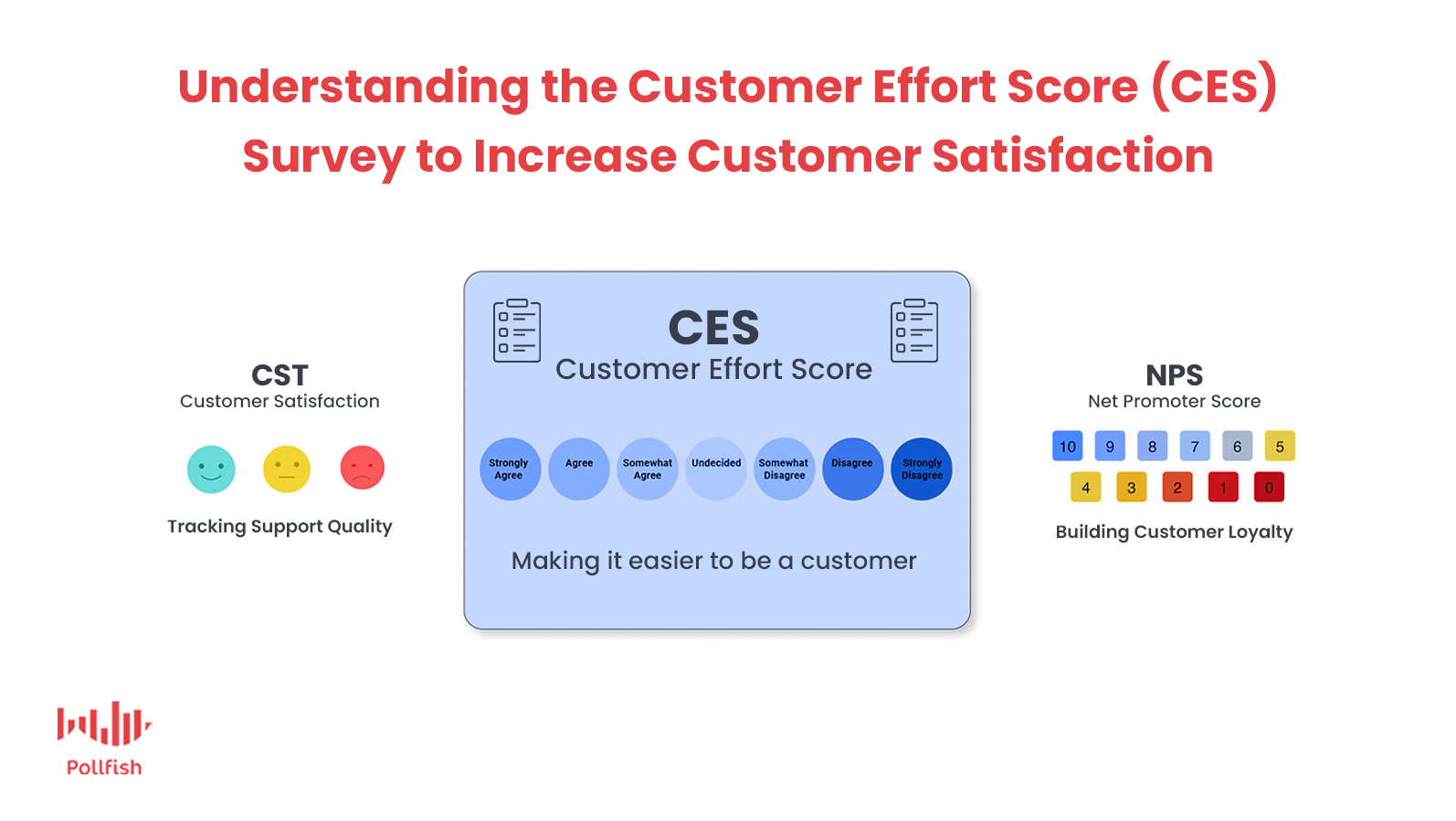 The Customer Effort Score survey, or CES survey, is one of the foremost customer satisfaction surveys. As a business owner or marketer, you ought to know that customer satisfaction holds colossal importance for your business.
The Customer Effort Score survey, or CES survey, is one of the foremost customer satisfaction surveys. As a business owner or marketer, you ought to know that customer satisfaction holds colossal importance for your business.
It can help drive customer loyalty, the key force behind retention, which ensures your customers return to your business instead of making one-time only purchases. Additionally, when brands produce high levels of customer satisfaction, they are increasing their customers’ Customer Lifetime Value (CLV), which incites higher value from customers.
Furthermore, customers want to know that their input is collected and valued, as 52% of worldwide customers believe that businesses need to take action on their feedback.
The CES survey is a potent survey tool to assess customer satisfaction — but it takes a very specific angle — that of measuring customer effort.
This article delves into the CES survey, explaining customer effort, why it’s important to measure it and all other key information so that your business makes the most out of this survey type.
Defining the CES Survey
Like its name implies, the Customer Effort Score survey measures customer effort, which is the degree or amount of effort that a customer puts into a certain interaction with a company.
Specifically, the CES survey is a survey that calculates the eponymous Customer Effort Score, a key customer experience metric that gauges customer effort.
Understanding Customer Effort
Customer effort refers to the degree of difficulty a customer has undergone to try to get an issue resolved. Additionally, it also generally refers to the ease (or difficulty) that a customer experienced with a certain service or experience with a company.
Understanding the Customer Effort Score
The Customer Effort Score is the heart of the CES survey. A customer experience (CX) score, it asks customers to rate the ease of completing an action — the customer effort in question; this is usually expressed on a scale of either “very difficult” to “very easy.”
The Customer Effort Score has a flexible setup: it can be derived from a scale of 1-5 and 1-7; it can be numeric and text-based.
There are 2 versions of the CES scale:
- In the older version, a 5-point scaled question asks: “How much effort did you use to complete this task?”
- In this scenario, 1 represents a very low effort, while 5 represents a very high effort.
- Thus the lower the number, the better the CES score, while a higher CES score meant more difficulty, therefore a bad score.
- In the newer version, a 5 (or 7, or 10-point) scaled question asks: “How much do you agree with the following?: The company made it easy for me to handle my issue.”
- This version presents a disagreement/ agreement rating scale.
- 1 represents “strongly disagree” while 5 or 7 represents “strongly agree”, so the scale is from negative to positive, (a higher number represents a better CES score), unlike the first version.
Calculating the Customer Effort Score
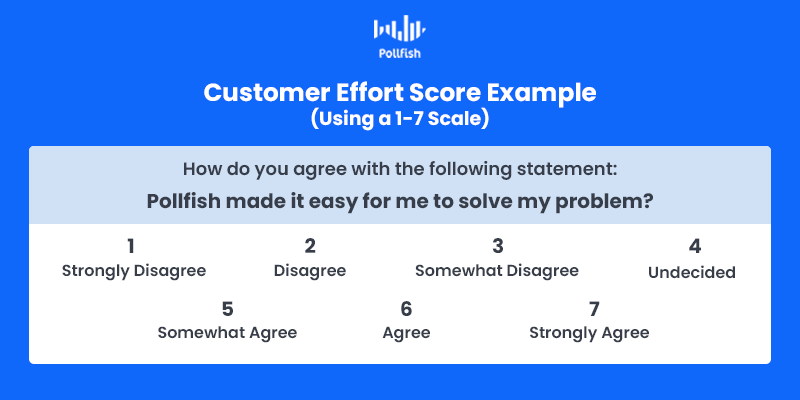
As you can gather, there are various ways to crunch customer effort, that is to derive a rating on customer effort. Once you’ve gotten a number from the scale (based on what your respondents answered with), you can take this further to determine the CES score.
There are several ways to calculate the Customer Effort Score. You can use whichever method you prefer for your CES survey. Either way, you’ll be a step closer to working out your customer satisfaction, most notably the degree of your customer effort.
Here are the three calculations to determine your CES:
- Average score: Used with the 1-10 scale. Get the complete sum of all the CES scores and divide it by the number of responses.
- Ex: total CES scores= 600, total respondents = 100
- 600/100= 6, CES= 6, i.e., 6 out of 10
- Via the Agree/Disagree scale or emojis (happy faces): Can be used with 1-5 or 1-7 scales. Subtract the percentage of positive responses from the percentage of negative responses. Do NOT use the neutral responses in the calculation.
- Ex: Total respondents = 300, positive responses =250, negative responses= 50
- % of positive responses = 83.33%, % of positive responses= 16.666%
- 83.33%- 16.666% = 66.664%
- CES score = 66.664%
- Via the 1-7 Disagree/Agree scale: Divide the total number of 5-7 responses (Somewhat Agree – Agree – Strongly Agree) by the total number of respondents. Then, multiple the result by 10 or 100 (if you prefer a percentage).
- Ex: total respondents = 200, 95 = number of positive responses
- 95/200 = 0.475
- 0.475 x 10 = 4.75, CES = 4.75 or
- 0.475 x 100 = 47.5%, CES = 47.5%
Remember, the higher the CES number is on the scale, the greater the Customer Effort Score. So which numbers are positive and which are negative?
- On a 1-7 scale, 5-7 are the positive answers, as they represent somewhat agree – agree – strongly agree.
- 1-4 are the negative responses; 5 is neutral.
- On a 1-5 scale, 4 and 5 are the positive responses.
- 1-2 are the negative responses; 3 is neutral.
- On a scale of 1-10, numbers 8-10 are the positive responses.
- 1-5 are the negative responses; 6 and 7 are neutral.
Why Your Business Needs a CES Survey
A high Customer Effort Score, to put it plainly, is good for business. As such, businesses need to measure their CES score periodically, to track how their customer effort is faring with customers.
A high score signifies that your company is making things easy for your customers.
A low score denotes that interacting with your business — even if it only concerns one aspect of it — is difficult for customers, as it requires too much effort from them.
Exceeding customer expectations is of the essence when it comes to retaining them. In order to create customer loyalists, you need to maintain a high Customer Effort Score, as it is the primary factor of customer satisfaction, along with loyalty and disloyalty.
According to Gartner Research, customers are 4 times more likely to be disloyal after they’ve had a service interaction. These unsatisfied customers negatively affect a company, as they spread their dissatisfaction via social media, forums, online reviews and word of mouth.
What’s more, is that a whopping 96% of customers with low CES scores become more disloyal to a business, as opposed to the meager 9% with high CES scores.
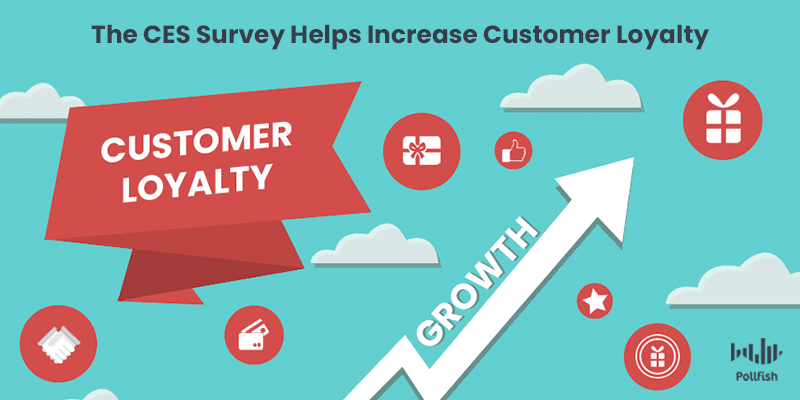
Brands need to make their CX as seamless as possible, so that customers require little to no effort when navigating through brands’ services and experiences.
A CES survey is the aptest instrument for measuring the Customer Effort Score, as it allows businesses to ask the CES question plainly in various parts of a customer journey.
Additionally, this survey is not limited to merely one question, as brands can allow respondents to expound on their score with follow-up questions particular to the interaction customers had just rated.
When to Use a CES Survey
Businesses ought to use a Customer Effort Score survey at various points in their customer experience. Here are a few of the most critical moments to send a CES survey to your customers and customer base:
- After a customer service interaction: whether it’s via phone, email, in-store or via chat, these are critical interactions that must be kept effort-free.
- Following a browsing session: after a customer visited several product pages, send the CES survey to understand whether it was easy for them to find what they were looking for.
- After an on-site search or navigation: Piggybacking off of point 2, gathering customer effort feedback is crucial after customers searched for pages within your site, via a search tab or navigation, as this shows you whether they can easily find what they need.
- After a purchase: This can be used to evaluate the ease of use of the checkout, including all of its steps, or about the steps (pages visited in the customer journey) that led to the purchase.
- Site revisit after no purchase: While it’s disappointing that customers left your site without purchasing if they’ve returned to your site, that’s good news. The CES survey allows you to gain insight into what about the checkout or other aspects of their CX led them to leave without purchasing.
The Pros and Cons of the CES Survey
The CES survey offers businesses a variety of benefits. There are also some setbacks to bear in mind before you launch a CES survey campaign. The following lists the advantages and disadvantages of the Customer Effort Score survey:
The Pros:
- Measures specific actions and events in a customer journey, allowing brands to zero in on what needs improvement the most.
- Allows companies to understand how to improve their CX at an overall level.
- Shows customers that your brand cares about their ease of use with your experiences.
- Boosts customer retention, as customers with high CES scores tend to make repeat purchases (as aforesaid).
- Low-effort interactions create lower costs — 37% less than a high-effort experience (Gartner, see above link) for a business.
- Increases customer loyalty, as fewer customers abandon a business that they are loyal to.
- Helps improve other customer satisfaction metric surveys, such as the NPS.
The Cons:
- Less adoption than the CSAT and NPS surveys.
- Less usage also means fewer benchmark data available to understand which scores are ideal, which are natural, etc.
- Limited to specific experiences.
- Not every customer will want to take a survey at every touchpoint.
Using Customer Effort to Scale Business
Customer satisfaction is the core of a business’s success, as happy customers will return, while dissatisfied ones will not only abandon a company, but leave their mark of discontent on the internet and elsewhere.
Businesses, therefore, need to monitor their customer satisfaction. There are several surveys that help businesses determine the state of their customer satisfaction. The CES survey, however, is unique in that it is the only survey dedicated to measuring customer effort.
Customer effort is a key hurdle (or non-hurdle when it’s low) to satisfaction. A high effort (meaning a low CES score) damages customers’ CX, thereby causing a dent in their customer satisfaction.
Your CX must be as seamless as possible so that the effort required to take any action from customers is hardly noticeable. This may seem like a tall order, but it isn’t, largely due to the CES survey. This survey helps brands study their customer effort at virtually any part of their CX.
The key is to find a strong online survey platform that can facilitate the Customer Effort Score survey process.
Frequently asked questions
What is a CES Survey?
Customer Effort Score (CES) survey determines the amount or extent of effort a specific customer puts into a particular interaction with a business.
What is customer effort?
Customer effort refers to the level of difficulty a particular customer has experienced to resolve a problem. In addition, it also typically refers to the difficulty or ease that a customer experiences with a specific service of a company.
How can you determine the CES score from a CES survey?
Businesses can deduce their CES score in 3 ways:
Average Score: Surveys using a 1-10 scale point can get a sum of all the CES scores and divide it by the number of responses
Agree/Disagree Scale: These surveys have a 1-5 or a 1-7 scale. Subtract positive responses from negative responses to get a CES score
1-7 Agree/Disagree Scale: These are responses that vary between the options of Somewhat Agree – Agree – Strongly Agree – Disagree – Somewhat Disagree, and so on
Why does your business need a CES survey?
CES (Customer Effort Score) is essentially used by businesses to track how effective their customer care is at dealing with customer's complaints and issues. To maintain a steady influx of buyers, companies should strive to maintain a higher CES score.
When should businesses use a CES survey?
Essentially, a business should use a CES survey to assess how easy or difficult a particular touchpoint has been for their customers. It is conducted to gauge the customer experience.
Diving Into the Customer Satisfaction Score Survey (CSAT) Survey
Diving Into the Customer Satisfaction Score Survey (CSAT) Survey
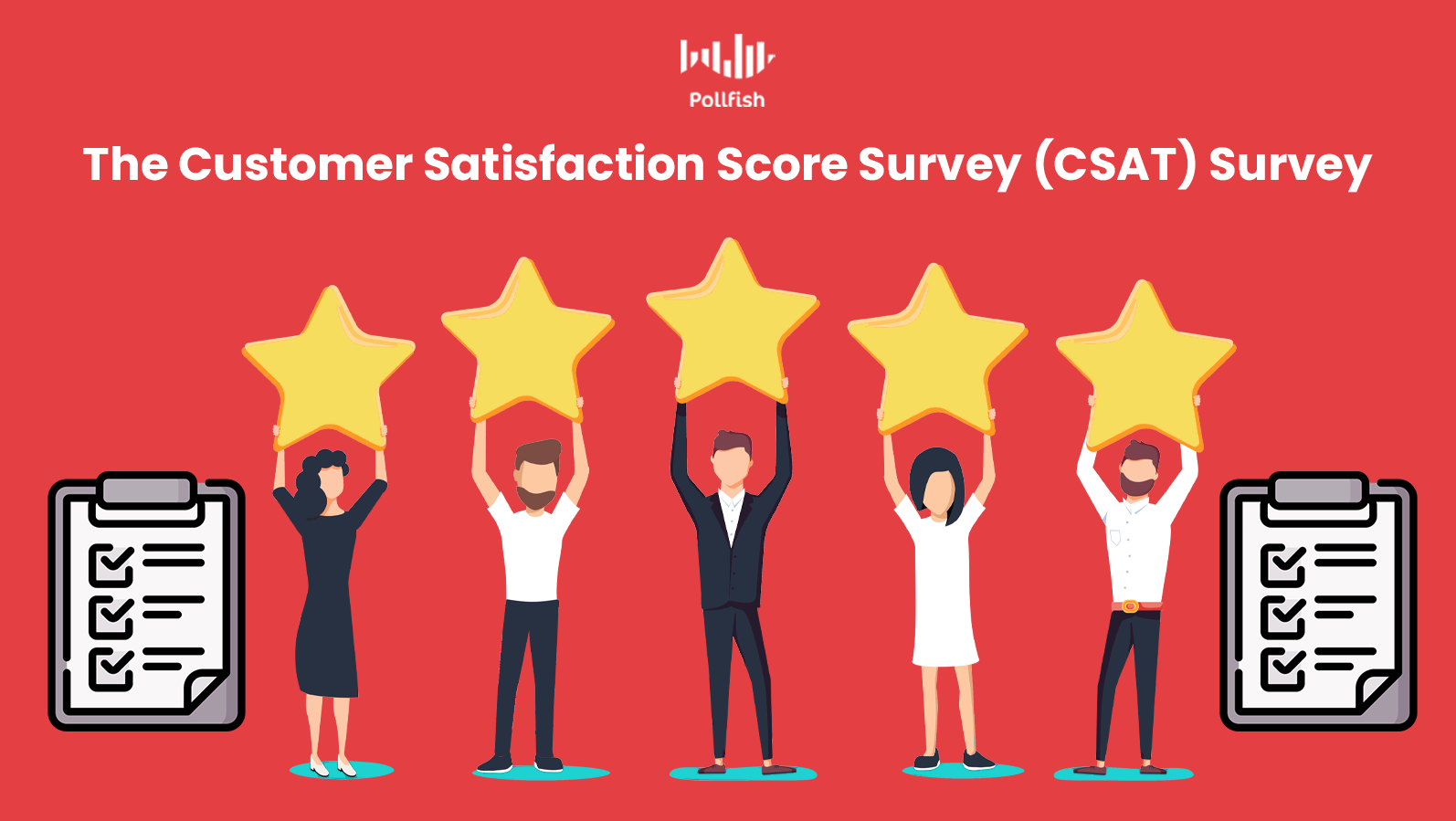
The Customer Satisfaction Score (CSAT) survey is an effective tool to measure customer satisfaction. Customer satisfaction has always been the chief performance goal for businesses, as customers are the lifeblood of any business.
The need to satisfy customers is at an all-time high, as a third of customers will leave a brand they love after just one bad experience, proving that companies need satisfaction upkeep of even their loyal customers. Nearly 60% of US consumers will abandon a brand after a few bad experiences.
Businesses, therefore, need a solid strategy that prioritizes customer satisfaction. A customer satisfaction survey, the CSAT survey is one of the foremost methods of gauging this crucial concept. This article delves into the customer satisfaction score survey and all that it entails and provides.
Defining the CSAT Survey
The Customer Satisfaction Score (CSAT) survey evaluates customer satisfaction based on a specific touchpoint in their customer journey, whether that’s in a website’s navigation menu, at checkout or while using a product they’ve already purchased (post-sales).
Another key differentiating factor of the CSAT survey is that this customer satisfaction survey is based on its eponymous score. This score signifies the percentage of satisfaction that customers endure and therefore, rate some point(s) in their customer experience (CX). Higher percentages reflect higher degrees of customer satisfaction.
Understanding this score helps businesses determine how segments of their target market assess their satisfaction in relation to their business. The CSAT survey comprises more than just the question used to calculate the score. Since it is a survey, it uses follow-up questions based on the respondents' answers. These can include open-ended questions so that respondents can elaborate on their CSAT rating.
How to Calculate the CSAT Score
The CSAT score is the heart of this survey. It uses a specific formula for its calculation. Although the CSAT survey measures a specific customer experience, market researchers can use it for general customer satisfaction assessments.
The CSAT score is measured with a Likert scale question type. The scale is between 1 and 5, in which 1 represents “highly unsatisfied” and 5 represents “highly satisfied.” 4 also represents predominantly satisfied customers.
The CSAT score is the most flexible type of customer satisfaction score, as it is not limited to the numbered scale. You can use various in-survey tools to exhibit the same sentiments as the 1-5 scale, such as emoticons, stars and other visual elements.
Here is an example of a general CSAT survey question, which responders answer with the aforesaid scale: How would you rate your overall satisfaction with our company?
Here is how you measure the CSAT score after you receive this critical variable:
CSAT= (Number of satisfied customers (4 and 5) / Number of survey responses) x 100
Round the result to the nearest whole number.
An example of the CSAT Calculation:
Number of satisfied customers (those who answered with a 4 or 5) = 32
Number of survey responses = 84
CSAT= (32/84) X 100
CSAT= 0.38 X 100
CSAT= 38%
As such, only 38% of respondents were satisfied.
How the CSAT Survey Differs from the Customer Effort Score (CES) & Other Surveys
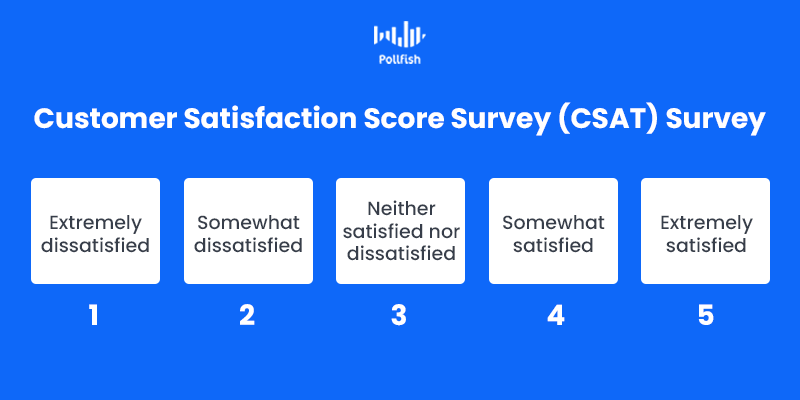
There are several other key customer satisfaction survey types. The two other main surveys are the Customer Effort Score (CES) survey and the Net Promoter Score (NPS) survey. Additionally, researchers can experiment with other customer satisfaction surveys, like ratings scale and custom surveys.
While it measures the same business aspect of customer satisfaction, the CSAT survey differs from the other such survey types, in that it studies particular things and thus has a discrete formula.
The Key Differentiators of the CSAT Survey
The following lays out the key facets of the CSAT survey. These distinguish it from other customer satisfaction surveys.
- Measures how satisfied or dissatisfied customers are at a particular time, with a particular service, procedure, interaction, product or any single CX moment.
- Uses a Likert scale question, with a scale of 1-5.
- Has two key outcomes: the score (whether its low (1-3) or high (4-5)) and the percentage of the high scores.
- Focuses on the latter, i.e., the percentage of satisfied (high) scores.
- Should be launched after a specific occurrence in the CX, such as:
- A technical support call
- A product demo
- A purchase
- Visiting a store
- Interaction with a UI element
The Customer Effort Score (CES) Survey DIfferences
The Customer Effort Score (CES) survey studies a completely different aspect of customer satisfaction. This survey measures the ease of service experience customers undergo with a business. Thus, it asks respondents to rate the ease of using a product or service via a Matrix-like question, on a scale ranging between “very difficult” and “very easy.”
Also a Likert scale question, the scale is usually between 1 and 5, in which 1 represents very low effort and 5 represents a very high effort. This can cause some ambiguity since the scale is inverted (1= good, as it’s low-effort/easy, 5= bad, as it’s high effort/difficult). 3 represents a neutral degree of effort in doing business with a company.
The Customer Effort Score formula:
(Very easy + easy answers) — (very difficult + difficult answers) = CES
Another way to calculate the CES: (sum of all individual scores) / all the respondents = CES
Following suit to the first calculation, the lower the score, the easier and thus more satisfying the experience is.
The Net Promoter Score (NPS) Survey DIfferences
The NPS survey differs from the CSAT survey in that it measures the likelihood of a customer to recommend a product or business to others. This survey is intended to understand customers’ outlook on a business, particularly their positive CX.
This is because the NPS question doesn’t merely question customer satisfaction — it asks whether customers reached a satisfaction high enough that would spur them into advocating for the business.
Respondents answer the NPS question on a scale of 0-10. The scale is divided into 3 sections of responders based on their scores.
- Detractors: Scores 0-6, they represent the low end/ negative sentiment
- Passives: 7-8 is the mid-range; their name denotes more of a neutral sentiment
- Promoters: 9-10 represents high customer satisfaction
The Net Promoter Score formula:
(Number of Promoter Scores/Total Number of Respondents) - (Number of Detractor Scores/Total Number of Respondents) = NPS score
The Customer Satisfaction Score survey is therefore divergent in its calculation along with the aspect it measures.
The Advantages and Disadvantages of the CSAT Survey
The CSAT survey is a nimble tool for tracking and measuring customer satisfaction. But as any survey tool, it too has a few limitations. It’s key to learn both its benefits and snags when deciding whether this survey type is the right one for your market research needs. The following posits the pros and cons, so that you can weigh them against each other during your deliberation.
The Pros
- Versatile measurements: It can be used across a wide range of interactions and experiences.
- Extremely flexible formatting: The grading scale is not limited to numbers. For a simple rating, researchers can use emoticons, stars, etc.

- Specific: Brands can spot-check different components of their CX, whether it’s digital or in-store and make precise improvements.
- Provides regular, up-to-date info: This survey can regularly be deployed as a check-up on your customer satisfaction, thus providing up-to-date customer feedback.
- Positive for your brand’s perception: Customers like it when their feedback is considered. When you specifically tie their opinions to your brand, you’re positing it in a good light.
- Can build benchmark data: By administering the same type of survey from time to time, you’ll be gaining continued insight that you can compare over time, allowing you to benchmark the data over several years.
- Simplicity in design: Although the question can pertain to all kinds of CX components, it is simple and requires few follow-up questions, unless you need a deep read of customer interactions.
The Cons
- Limits with specificity: Since it zeroes in a specific touchpoint, the feedback is limited to that experience only. It doesn’t provide a wider view of the overall customer relationship.
- Can overwhelm respondents: Although a simple survey, the CSAT warrants constant check-ups for updated info and benchmarking. This can irritate repeat customers or even first-time buyers.
- Privacy concerns: Not all interactions are private. A purchase, for example, isn’t private in that customers provide their names, addresses and credit/debit card details. As such, their identities are tied to their CSAT survey responses. This can be concerning for customers that value their privacy and want to maximize it.
When to Use the CSAT Survey
The capability of being used to survey everything can mean nothing for market researchers and business owners who want to narrow down the most expedient opportunities for measuring customer satisfaction.
As such, here are some of the most opportune moments and occurrences in your customers’ CX for you to employ the CSAT survey.
- Customer support interactions
- Chatboxes, emails and all other digital communications
- On the phone
- In-store and at a support center
- Sales interactions
- In-store
- During a meeting whether it’s via Zoom or in-person
- Over the phone
- During a marketing event, tradeshow, etc.
- Customer onboarding
- Particular to SaaS companies
- Includes products/services that require training (mainly for professionals)
- Event feedback
- Digital events like webinars, company introductions, etc.
- In-person events from grand openings, to sales weeks, etc.
- Site Navigation
- Homepage
- Landing pages
- Product pages
- Banners
- Ads
- Checkout
- Search bar
- Product Satisfaction
- Newly purchased products
- Products owned for a period of time (from weeks to a year)
There is virtually no limit to testing customer satisfaction with the CSAT survey, as it can be adapted to test all customer experiences.
Taking Your Customer Satisfaction Above and Beyond
The CSAT is but one consumer survey, but it has a major takeaway: the importance of keeping your customers happy. With customer expectations at an all-time high, it is integral to provide them with experiences that raise their customer satisfaction.
In essence, customer satisfaction measures a consolidation of customer perceptions and expectations. While it is impossible to meet every expectation, achieving a good perception is doable. In order to meet this end, you need to constantly study your customers in relation to their satisfaction with your business.
Online surveys are the most effective measures in this regard, in that they catch customers in their natural environments. Regarding the CSAT score, online surveys empower it, as market researchers can place and launch surveys during various customer interactions. The more you study your customer satisfaction, the better you can perfect it.
Frequently asked questions
What is a customer satisfaction score (CSAT) survey?
Customer satisfaction is essential for any business, and therefore, it is important to measure how customers feel about the offerings. Customer satisfaction or CSAT survey is one of the foremost methods of gauging this crucial metric.
How does the customer satisfaction score work?
A Customer Satisfaction Score (CSAT) survey evaluates the customer's satisfaction based on a specific touchpoint. For example, it could be a customer's interaction with the brand's website, checkout, or experience during purchase. The score represents the percentage of satisfaction that the customer felt and adds the rating to the overall customer experience (CX).
How is a customer satisfaction score measured?
The CSAT score is evaluated on a Likert scale question. The customer is asked to rate their experience on a scale of 1 to 5. 1 signifies highly unsatisfied customers while 5 represents highly satisfied.
What is the difference between the customer effort score survey and the customer satisfaction score survey?
The Customer Effort Score (CES) surveys show how easy and comfortable customers feel while interacting with a business. On the other hand, a CSAT score is determined based on consumer feedback. It asks customers to rate their experience using a product or a service, whereas a customer satisfaction score evaluates a customer's satisfaction at a given customer touchpoint.
What are some advantages of the CSAT survey?
There are several advantages of using a CSAT survey that include versatile measurements, benchmarking data for continued insights, flexible formatting, and spot-checking different components of a CX application. These things help in deducing customers’ satisfaction at a particular touchpoint that can help boost engagement and understand customer’s preferences better.
Diving Into the Net Promoter Score (NPS) Survey
Diving Into the Net Promoter Score (NPS) Survey

The Net Promoter Score (NPS) survey is one of the most prominent customer satisfaction surveys. Based on its eponymous score, this survey measures one of the most critical aspects of customer satisfaction: loyalty.
While brand awareness and product / experience satisfaction are invaluable for any business, loyalty is the only guaranteeing factor that assures your customers will return to your brand for future purchases. As a matter of fact, 43% of customers spend more on a brand that they’re loyal to.
Brands should thus keep track of their NPS score, as it is one of the top indicators of customer loyalty. The best way to do so is by running NPS surveys. This article will take a deep dive into this survey type and guide you on several best practices.
Defining the Net Promoter Score
As its name indicates, the Net Promoter Score survey is a survey based on its titular Net Promoter Score. The score is a key customer satisfaction metric, as it reveals how likely a customer is to recommend a product or company to a friend or colleague.
The score is derived by asking just one question, known as the Ultimate Question in relation to the above. The responder answers the question using a scale of 0-10. 0-6 is the low end of the scale, denoting negative sentiment towards the brand and thus a low chance of receiving a customer’s recommendation.
Conversely, 9-10 is the higher end of the scale, signifying a high chance of customer satisfaction and recommendation of the company. 7-8, although they appear on the higher end, are known to be the mid-range.
This scale is only one aspect of the NPS, as it requires using respondents’ combined answers to find the score in a particular study. Thus, an NPS survey is the vehicle used in obtaining and enriching this score.
Let’s observe the nuances of the NPS score and how to calculate it.
How to Calculate the NPS and its Numerical Significance
Delving into the specifics of this score, you’ll find that the numbers represent more than just the “not likely” and “extremely likely” points of view.
On the contrary, the NPS score designates several types of customers based on their answers: the detractors, the passives and the promoters.
It also requires a calculation, as the respondents’ answer itself does not represent the final score. First, you’ll need to know the customer classification in the NPS, which is based on the answers the respondents give. Here is the numerical significance for each answer range:
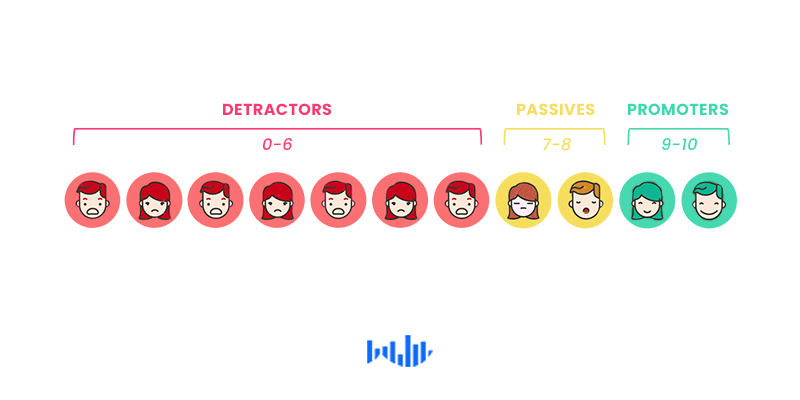
- 0-6: The Detractors: The most unlikely group to recommend your company or product.
- Unlikely to stay on your website for long or make repeat purchases
Tend to be naysayers, which means they can intentionally discourage other customers from buying from your brand. - Can spread negative opinions about your brand on social media, forums or word of mouth.
- 7-8: The Passives: The somewhat satisfied group of customers susceptible to buying from your competitors.
- Won’t actively recommend your brand, yet aren’t likely to harm it with negative feedback.
- Not used in the NPS calculation.
- Close to being promoters (especially if they respond with an 8)
- Opportune for brands to study and nurture this group, as they are the easiest to convert to promoters.
- 9-10: The Promoters: The most loyal customers who make continuous purchases from your brand and refer others to it.
- Most likely to act as brand ambassadors and augment your brand’s reputation.
- Most responsible for a company's growth.
- Increase referrals, thereby increasing brand awareness.
You will need to understand these to calculate the Net Promoter Score. Here is how to do so:
- Subtract the percentage of Detractors from the percentage of Promoters.
- For example, if 15% of respondents are Detractors, 20% are Passives and 60% are Promoters, your NPS score would be 60-15 = 45.
- The NPS= 45, as it is always represented as a digit, not a percentage.
- A higher NPS score points to a larger amount of promoters, which is most ideal.
The NPS Survey Measures & Correlates with Growth
A Net Promoter Score survey puts the score to greater use by providing it with context. As such, this type of survey does not merely ask the Ultimate Question; it can ask more for a more lucid context.
This is to say that despite the NPS being the bulk of an NPS survey, it is just that: a part of it but not its entirety. This survey is capable of not only measuring growth but it has proven to correlate with it.
According to Bain & Company, which devised the Net Promoter System, the score can determine growth. Bain conducted a study on the correlation between the NPS and organic growth, measuring this score among business competitors in different industries
Bain concluded that the NPS correlated with 20%-60% of organic growth among these competitors. What’s more is that Net Promoter Score leaders went on to outgrow their competitors by more than twice.
This proves the urgency of tracking one’s NPS and a Net Promoter Score survey helps do just that. This score will enlighten your business on how to improve on several fronts. To understand how you must understand the other questions and facets of an NPS survey.
The Components of an NPS Survey & How they Provide Key Insights

Aside from asking the Ultimate Question, there are a few other capabilities you can configure to fortify your customer satisfaction measurement. These will provide much more context than a number (the NPS) can alone.
Here are some other ways your business can benefit from a Net Promoter Score survey based on its components.
- You can set up the NPS survey to measure virtually anything instead of simply obtaining a general NPS for your brand. You can use it measure:
- Products
- Interactions with representatives
- UX
- Brick and mortar stores & more
- If looking for insight into something specific, you can implement the NPS survey in various parts of the customer journey, such as:
- The homepage
- A landing page
- A product page
- At checkout
- Post checkout/purchase
- You can perform market segmentation by using demographics as part of your survey. This will help you create groupings of respondent answers based on their demography. You can thus make educated deductions on how your NPS answers correlate with different demographics.
- The added questions. You can use the survey to extract key contextual information that a score alone wouldn’t grant you, such as:
- Finding the exact reason behind a respondent's number. For example:
- What are the main reasons for the score you gave us?
- What makes you feel this way?
- Improving customer and user experience. For example:
- What can Pollfish do to improve your experience?
- How can we improve this product, interaction, etc?
- Following up with the respondents to learn more about their concerns on a more granular level. For example:
- Can we follow up with you about your responses?
- Can we follow up with you to see how we can improve your experience?
- Finding the exact reason behind a respondent's number. For example:
Transactional vs Relational NPS Surveys
Now that we’ve established and elucidated the utility and importance of Net Promoter Score surveys, let’s examine the two main types of NPS surveys.
These surveys are classified as relational and transactional NPS surveys. They are categorized based on both their frequency and purpose of deployment.
- Relational NPS Surveys:
- Deployed periodically, such as every quarter, annually or monthly.
- Designed to keep regular track of customer sentiment, find patterns and detect changes in attitudes toward your brand overall.
- Provide “health check-ins” on customers as a way to measure success.
- Transactional NPS Surveys:
- Distributed after a customer interacted with your company (ex: post purchases or conversation with a representative).
- Used to understand customer satisfaction in more depth.
- Based on specific topics.
The success of your brand depends on using both of these types of surveys to fully comprehend your customer loyalty. If you rely on sending out various transactional NPS surveys, then you ought to adjust your relational surveys to a lesser frequency.
If you rarely deploy transactional surveys, you should dispense more frequent relational surveys. To find the correct balance of using both, examine all of your survey feedback. Look for things you find to be missing and once you do, determine which type of survey these concerns best fall under.
Customer Loyalty and Long-Term Business Success
The main insight you can glean from Net Promoter Score surveys is how loyal your costumes are, and of course, how many customers can damage your reputation.
Through more detailed questions, you can pinpoint the reasons behind your customers’ satisfaction or dissatisfaction with your company as a whole or a particular component.
This allows you to innovate better, augment your offerings and fix any bugs (whether it’s with an online experience, a salesperson or any other feature). As mentioned above briefly, one of the benefits of this type of survey is its versatility; it can be used to measure satisfaction with just about anything.
The goal is to use the insights you’ve acquired through this survey to gain loyal customers, the kinds who transcend the notion of “customer,” by becoming brand evangelists.
Frequently asked questions
What is the Net Promoter Score (NPS) survey?
The Net Promoter Score (NPS) survey is a type of survey that seeks to understand customer satisfaction by measuring how likely it is that a customer will recommend a product, company, or service to a friend or associate.
How many questions are included in the NPS survey?
The NPS survey typically requires just one question, which asks: “How likely are you to recommend [company, product, or service name] to a friend or colleague?” Researchers can expand on it, so it resembles a full-fledged survey by adding more relevant questions.
How is the Net Promoter Score calculated?
The Net Promoter Score is calculated by subtracting the percentage of Detractors from the percentage of Promoters. Respondents who gave a Passive response are not included in the calculation. The NPS is then described as a number rather than a percentage.
How can the NPS predict growth?
Studies have demonstrated a correlation between a high NPS and organic growth. Those who achieved high Net Promoter Scores tended to outpace their competitors in organic growth.
What types of businesses can benefit from conducting a NPS survey?
All types of businesses can benefit from using an NPS survey. Brick and mortar stores and online shops can benefit equally, as can those selling any type of product or service.
Diving Into the Customer Satisfaction Survey
Diving Into the Customer Satisfaction Survey
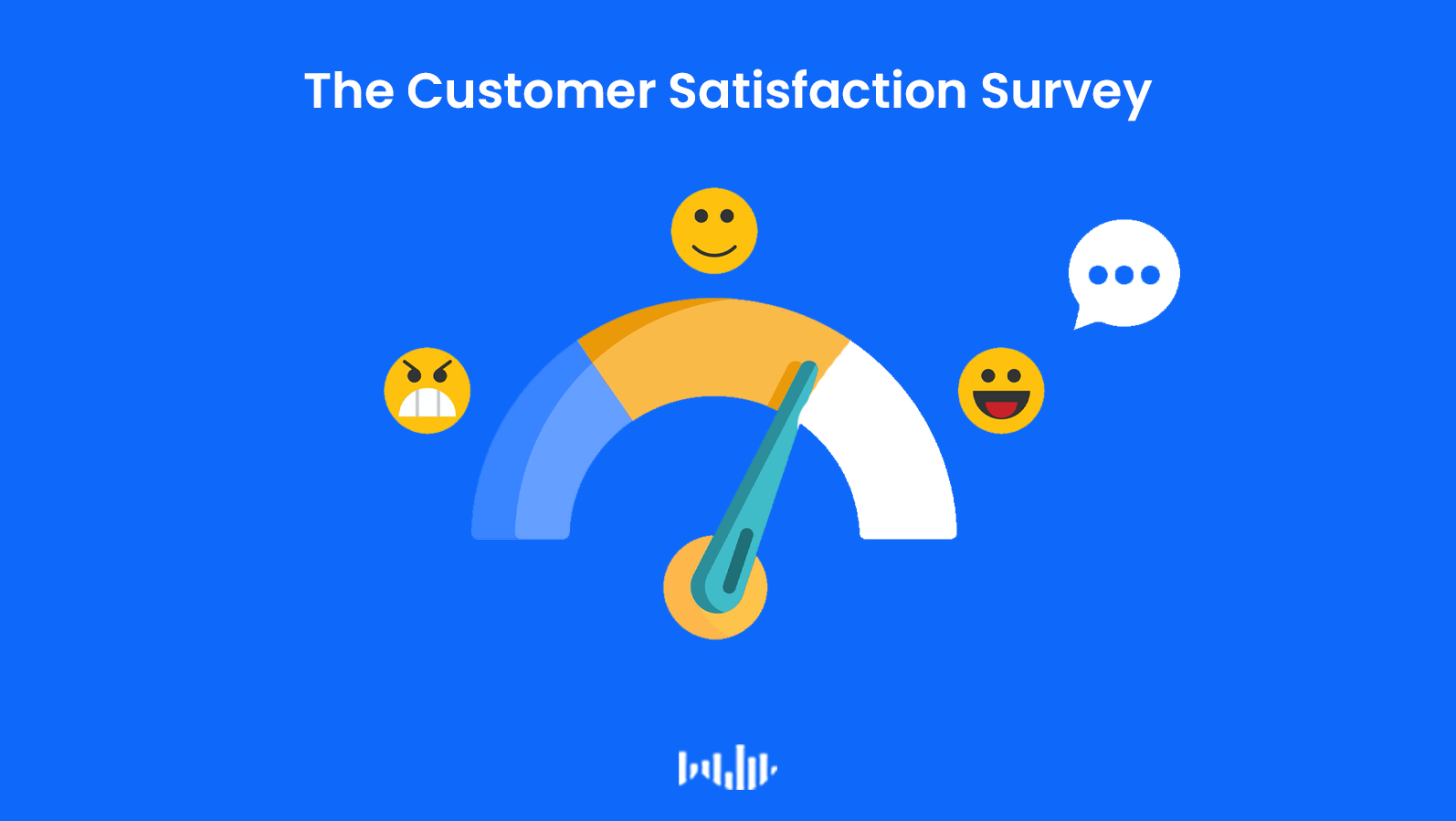
Customer satisfaction. This lofty achievement is often, if not always, the main objective for businesses small and large.
It goes without saying that this concept is attributed to revenue, continued purchases, customer loyalty and brand awareness (via reviews and mentions by happy customers).
So how can your business accomplish customer satisfaction? By putting the customer satisfaction survey into practice.
This survey is specifically tailored to gauge customer satisfaction within your niche, and most importantly, within your company. This article will explore this survey type and how you can optimize it for all your business needs, including market research, marketing and more.
Defining Customer Satisfaction
This term appears to be self-evident, but for business purposes, it is best to understand it precisely before you venture out on any efforts to perfect it — or if you’re a startup — to reach it.
Customer satisfaction denotes the measurement that ascertains the degree to which customers are satisfied with a company’s products, services and experiences. In short, it reveals whether your customers are happy with your offering and by how much.
Your business can determine its own levels of customer satisfaction with the customer satisfaction survey.
The Customer Satisfaction Survey & its Applications
As its name implies, a customer satisfaction survey is a survey developed for businesses to understand what their customers think about their products, services and company at large.
As such, this kind of survey can cover all the bases of customer satisfaction, such as user experience, mobile experience, customer support and all the other facets of doing business/ interacting with your company.
The customer satisfaction survey can take the form of a questionnaire, or a ratings-based survey (think numerical values, stars and other icons used to express good or poor satisfaction).
This kind of survey can be used in a number of different campaigns, based on their macro applications. These include:
These applications may seem too broad to be used for uncovering customer satisfaction alone — and they are. These macro applications serve as the starting points of survey research, which in turn can be used to buttress them. The same applies to a customer satisfaction survey, which can be used in relation to these campaigns.
For example, you can test how satisfied customers are with a product, as it relates to an advertising campaign around it.
Or, perhaps you need to test your customer support satisfaction for branding. You may conduct a survey that asks about specific wording your representatives may have used.
There are several ways to form a customer satisfaction survey.
5 Types of Customer Satisfaction Surveys
You can design these surveys in a number of ways, but there are five main types of formats that these surveys take. Each survey type provides a different kind of angle into customer satisfaction. As such, they should be used at different points in the customer journey.
Net Promoter Score Surveys (NPS)
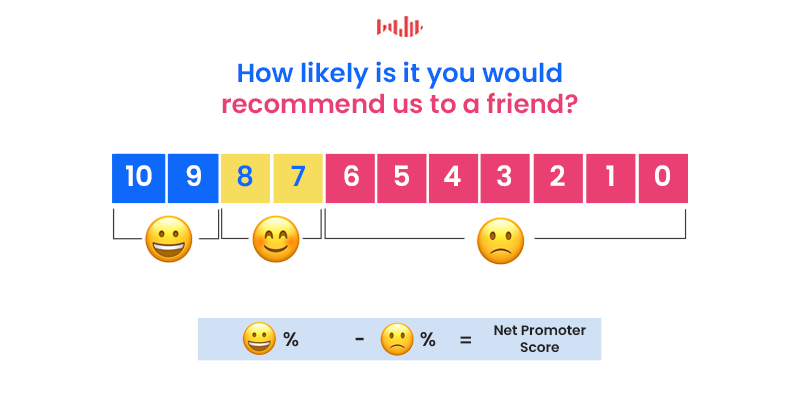
Conceived in 2003 by Fred Reichheld, of Bain & Company, the Net Promoter Score (NPS) survey has become prominent across industries. This score-based survey asks customers to rate the likelihood of their recommending your business, on a scale of 0-10.
The respondents who ranked their likelihood between 0-6 are known as the detractors, those who are generally unhappy with your product, service or experience.
Those who respond in the 7-8 range are called passives, as they are not impressed with your company, but aren’t dissatisfied either. They are situated in the middle of this score, despite their numbers going slightly past the mid-section.
Respondents in the 9-10 range are the most ideal, as they represent the promoters of your business; they are on the higher end of satisfaction.
To calculate your NPS, subtract the percent of detractors away from the percent of promoters. For example, if 60% of responses were Promoters and 15% were Detractors, your Net Promoter Score would be 45. (The NPS is expressed as a digit, not a percentage.
Pro tip: Always add a follow-up open-ended question, so that your customers can explain why they selected their rating.
Customer Satisfaction Score (CSAT)
The CSAT represents a customer’s fulfillment in a particular situation. This is where you can apply this survey to a wide range of applications. For example, you can assess customer happiness during an interaction with a salesperson or with a product feature.
The Customer Satisfaction Score is made up of two parts: a numerically-based question and an open-ended question. The numerically-based question is a scale representing satisfaction.
The CSAT can ask, for example, to rate satisfaction with an experience from a scale of 1 (very dissatisfied to 5 (very satisfied).
To calculate the CSAT, use the following formula: The total number of satisfied responses / total number of responses) x 100. Round the result to the nearest whole number.
Respondents who answer this with either 4 or 5 are considered to be satisfied customers.
Pro tip: Use the CSAT to understand your customer sentiment at a specific point in time. This includes after a product demo, after a technical support call, after visiting a service center or store.
Customer Effort Score (CES)
This type of survey measures the amount of effort that was required for a customer to take part in an action. This survey focuses solely on the process of achieving an end result. Also called the effort, measuring the process determines how easy or difficult the flow is in your product/service.
As such, even if the result may be enjoyable to the customer, the process itself may not be.
This service is important, as brands today must provide quality experiences; the product or service alone is not enough. To fully satisfy customers, brands must make it smooth and easy to complete any process, whether it’s signing up for a subscription or ordering a product.
To calculate the CES, use a 5-point scale to gauge the ease of the customers’ actions. For example, it is common to ask: “how easy was it to find this product on our site?” The options should range from “very difficult,” to “somewhat difficult,” to “somewhat easy” and so on.
The answers on the “disagree” side of the spectrum would be number 1 and 2. 3 would be neutral, while 4 and 5 would be on the “agree” side. The CES is centered around the “agree” answers.
As such, to find the CES add all the “agree” answers (either 4 or 5), then divide them by the total number of respondents.
For example, if 100 customers replied with a 4 or 5, but there are 200 of them who took the survey, 50% of them are in the “agree” range. That means your CES score is 50. Brands ought to aim for high CES scores, as it points to customers happy in achieving an intended outcome.
Visual Rating Surveys
Also called emoji surveys, visual rating surveys allow customers to respond with graphic, rather than with a number. All the choices they can select are composed of a graphic and there are various ones you can use.
Each answer shows a different amount of each graphic to express the level of satisfaction. For example, a question on how satisfied customers are with a service can range from 1 to 5 stars or other emojis.
Here are a few examples of the types of visual rating surveys:
- Star surveys
- Heart surveys
- Thumbs up/down surveys
- Smiley surveys
These kinds of surveys are visually appealing, easy to complete and take little to no time to finish.
Custom Surveys
Best used to understand how and why customer satisfaction was exceeded, met or failed to reach expectations, these surveys are often used as follow-ups to previous surveys.
Custom surveys include questions that delve further into customer satisfaction to discover specifics that other surveys could not make readily available.
To piggyback on previous surveys or previous responses, you can ask follow-up questions by way of advanced skip logic. This will automatically direct your respondents to different question paths, depending on the answers they provided.
You should organize your custom survey feedback into three segments: fix now, fix later and fine as is. This will allow you to see which issues and experiences are the most pressing and which can be amended later.
6 Types of Questions to Use in a Customer Satisfaction Survey
The types of questions you use will largely depend on the kind of survey type you implement into your customer satisfaction campaign.
However, since they all fall under the same research campaign and measure virtually the same thing, there is going to be a lot of overlap between the questions you use for each survey type.
The following lays out the 6 question types to use for measuring customer satisfaction.
- Multiple-choice questions: limit the number of answers a respondent can use. Little effort is required to answer (as opposed to open-ended questions).
- They can include rating scale questions, binary scale questions, nominal questions, Likert scale questions, and semantic differential questions.
- Rating scale questions: use multiple-choice questions that correspond to a scale, such as the CSAT, for customer support, or the probability of product recommendation (NPS)
- These are also called ordinal questions.
- Binary scale questions: Allow for only two answers, such as yes or no, or a thumbs up or down.
- These are used to cut back on obscure results.

An example of a binary scale question
- These are used to cut back on obscure results.
- Nominal questions: Use different categories of answers with no numbers attached.
- Likert scale questions: Questions on a 5-7-point scale to assess customer sentiment.
- 1 represents the lowest end of the view (strongly disagree) while 7 is at the highest end of the opinion (strongly agree)
- Semantic differential questions: Uses a 5-7-point scale, but goes beyond agreeing and disagreeing.
Using this Survey to Lure in New Customers
Unlike other surveys, which are used to scrutinize your target market, identify it or segment it further, the customer satisfaction survey deals solely with customers, ie, the segment that has already bought from you.
Not everyone in your target market is a customer, as this group denotes the people most likely to buy from you — not the people who already made a purchase.
Customers are every bit as important to study as prospects, as they help you discover what your company exceeds at and where there’s room for improvement. Measuring customer satisfaction will inform your business on how to better prepare your service, experiences and offerings for everyone in your target market.
As such, you’ll know how to better lure in new customers and upkeep their satisfaction. But most importantly, a customer satisfaction survey helps bridge the gap between one-time purchasers and loyal customers. Retaining your customers is key to keeping your business afloat, as they represent a continuous stream of revenue and revenue opportunities.
Frequently asked questions
What is a customer satisfaction survey?
A customer satisfaction survey is a type of survey that is designed to measure how happy or satisfied existing customers are with a product or service.
What is a Net Promoter Score survey?
A Net Promoter Score (NPS) survey is a short survey that is used to measure the likelihood that someone will recommend a product, service, or company to someone else. The survey is a good way of gauging overall customer satisfaction.
What is a CSAT?
A CSAT, or Customer Satisfaction Score, is a short survey that measures how satisfied a customer was with a specific situation. It consists of a numerical-based question and an open-ended response.
What is a Customer Effort Score?
A Customer Effort Score (CES) is a survey that measures the amount of effort required to complete a certain action. The survey consists of a single question with a 5-point scale response.
What is a binary scale question?
A binary scale question is a type of survey question that has only two possible responses (e.g. yes or no).



